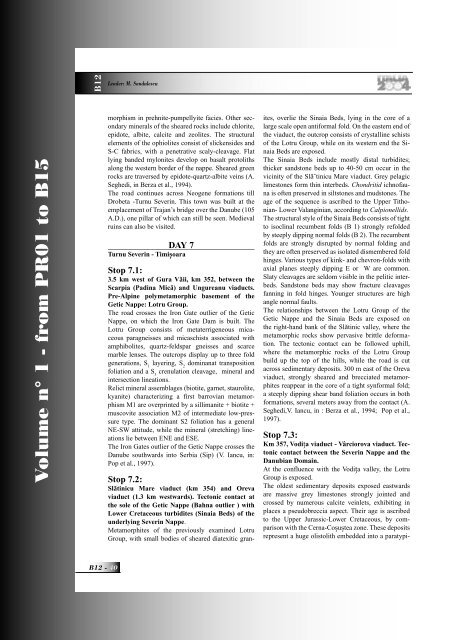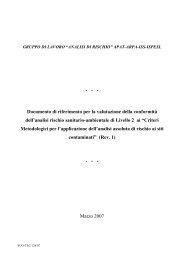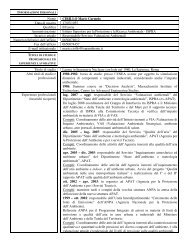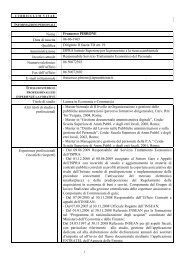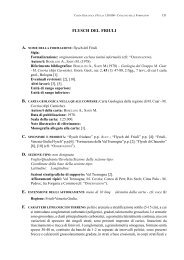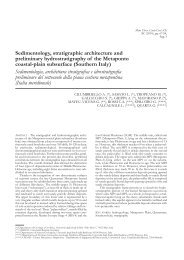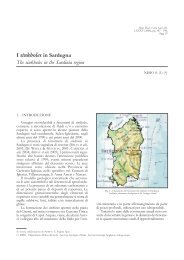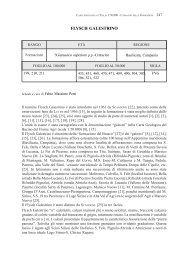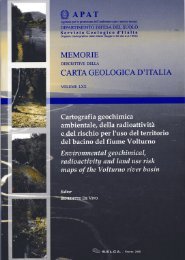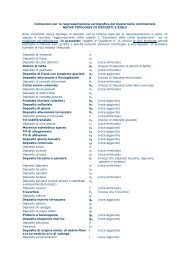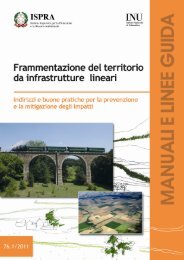Guidebook - Ispra
Guidebook - Ispra
Guidebook - Ispra
Create successful ePaper yourself
Turn your PDF publications into a flip-book with our unique Google optimized e-Paper software.
Volume n° 1 - from PR01 to B15<br />
B12<br />
B12 -<br />
Leader: M. Sandulescu<br />
morphism in prehnite-pumpellyite facies. Other secondary<br />
minerals of the sheared rocks include chlorite,<br />
epidote, albite, calcite and zeolites. The structural<br />
elements of the ophiolites consist of slickensides and<br />
S-C fabrics, with a penetrative scaly-cleavage. Flat<br />
lying banded mylonites develop on basalt protoliths<br />
along the western border of the nappe. Sheared green<br />
rocks are traversed by epidote-quartz-albite veins (A.<br />
Seghedi, in Berza et al., 1994).<br />
The road continues across Neogene formations till<br />
Drobeta -Turnu Severin. This town was built at the<br />
emplacement of Trajan’s bridge over the Danube (105<br />
A.D.), one pillar of which can still be seen. Medieval<br />
ruins can also be visited.<br />
DAY 7<br />
Turnu Severin - Timișoara<br />
Stop 7.1:<br />
3.5 km west of Gura Văii, km 352, between the<br />
Scarpia (Padina Mică) and Ungureanu viaducts.<br />
Pre-Alpine polymetamorphic basement of the<br />
Getic Nappe: Lotru Group.<br />
The road crosses the Iron Gate outlier of the Getic<br />
Nappe, on which the Iron Gate Dam is built. The<br />
Lotru Group consists of metaterrigeneous micaceous<br />
paragneisses and micaschists associated with<br />
amphibolites, quartz-feldspar gneisses and scarce<br />
marble lenses. The outcrops display up to three fold<br />
generations, S 1 layering, S 2 dominanat transposition<br />
foliation and a S 3 crenulation cleavage, mineral and<br />
intersection lineations.<br />
Relict mineral assemblages (biotite, garnet, staurolite,<br />
kyanite) characterizing a first barrovian metamorphism<br />
M1 are overprinted by a sillimanite + biotite +<br />
muscovite association M2 of intermediate low-pressure<br />
type. The dominant S2 foliation has a general<br />
NE-SW attitude, while the mineral (stretching) lineations<br />
lie between ENE and ESE.<br />
The Iron Gates outlier of the Getic Nappe crosses the<br />
Danube southwards into Serbia (Sip) (V. Iancu, in:<br />
Pop et al., 1997).<br />
Stop 7.2:<br />
Slătinicu Mare viaduct (km 354) and Oreva<br />
viaduct (1.3 km westwards). Tectonic contact at<br />
the sole of the Getic Nappe (Bahna outlier ) with<br />
Lower Cretaceous turbidites (Sinaia Beds) of the<br />
underlying Severin Nappe.<br />
Metamorphites of the previously examined Lotru<br />
Group, with small bodies of sheared diatexitic gran-<br />
ites, overlie the Sinaia Beds, lying in the core of a<br />
large scale open antiformal fold. On the eastern end of<br />
the viaduct, the outcrop consists of crystalline schists<br />
of the Lotru Group, while on its western end the Sinaia<br />
Beds are exposed.<br />
The Sinaia Beds include mostly distal turbidites;<br />
thicker sandstone beds up to 40-50 cm occur in the<br />
vicinity of the Slă˘tinicu Mare viaduct. Grey pelagic<br />
limestones form thin interbeds. Chondritid ichnofauna<br />
is often preserved in siltstones and mudstones. The<br />
age of the sequence is ascribed to the Upper Tithonian-<br />
Lower Valanginian, according to Calpionellids.<br />
The structural style of the Sinaia Beds consists of tight<br />
to isoclinal recumbent folds (B 1) strongly refolded<br />
by steeply dipping normal folds (B 2). The recumbent<br />
folds are strongly disrupted by normal folding and<br />
they are often preserved as isolated dismembered fold<br />
hinges. Various types of kink- and chevron-folds with<br />
axial planes steeply dipping E or W are common.<br />
Slaty cleavages are seldom visible in the pelitic interbeds.<br />
Sandstone beds may show fracture cleavages<br />
fanning in fold hinges. Younger structures are high<br />
angle normal faults.<br />
The relationships between the Lotru Group of the<br />
Getic Nappe and the Sinaia Beds are exposed on<br />
the right-hand bank of the Slătinic valley, where the<br />
metamorphic rocks show pervasive brittle deformation.<br />
The tectonic contact can be followed uphill,<br />
where the metamorphic rocks of the Lotru Group<br />
build up the top of the hills, while the road is cut<br />
across sedimentary deposits. 300 m east of the Oreva<br />
viaduct, strongly sheared and brecciated metamorphites<br />
reappear in the core of a tight synformal fold;<br />
a steeply dipping shear band foliation occurs in both<br />
formations, several meters away from the contact (A.<br />
Seghedi,V. Iancu, in : Berza et al., 1994; Pop et al.,<br />
1997).<br />
Stop 7.3:<br />
Km 357, Vodiţa viaduct - Vârciorova viaduct. Tectonic<br />
contact between the Severin Nappe and the<br />
Danubian Domain.<br />
At the confluence with the Vodiţa valley, the Lotru<br />
Group is exposed.<br />
The oldest sedimentary deposits exposed eastwards<br />
are massive grey limestones strongly jointed and<br />
crossed by numerous calcite veinlets, exhibiting in<br />
places a pseudobreccia aspect. Their age is ascribed<br />
to the Upper Jurassic-Lower Cretaceous, by comparison<br />
with the Cerna-Coșuștea zone. These deposits<br />
represent a huge olistolith embedded into a paratypi-


